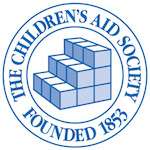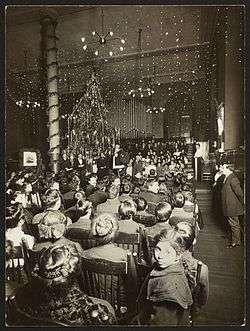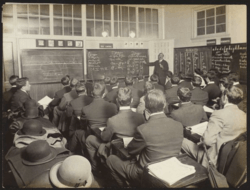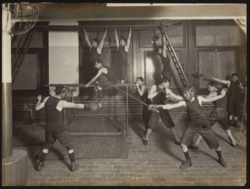Children's Aid Society
 | |
| Formation |
1853 New York, New York, U.S. |
|---|---|
| Founder | Charles Loring Brace (Yale College, 1846)[1][2] |
Region served | New York City |
President | Phoebe C. Boyer (Columbia Business School, MBA)[3] |
Revenue |
$137.3 million (2013) |
| Expenses |
$121.7 million (2013) |
Staff | 1,200+ full-time |
| Website | childrensaidsociety.org |
| Remarks |
Firsts:[5]
|
- See also Children's Aid Society (Canada).
Children’s Aid Society (CAS) is a private, child welfare nonprofit in New York City, founded in 1853 as the Orphan Train originator, by Yale College graduate,[1][2] Charles Loring Brace. With an annual budget of over $100 million, 45 citywide sites, and over 1,200 full-time employees, CAS is one of America's oldest and largest children's nonprofits.
CAS helps tens of thousands of disadvantaged, New York City children succeed annually, by providing comprehensive services of adoption and foster care, after-school and weekend programs, arts, camps, early childhood education, events, family support, medical, mental health, and dental, juvenile justice, legal advocacy, special initiatives, sports and recreation, and youth development programs.[6][7]
History




In 1853, Children's Aid Society was founded by Yale College graduate[1][2] and philanthropist, Charles Loring Brace, with financial support from New York businessmen and philanthropists,[1] to ensure the physical and emotional well-being of children, and provide them with the support needed to become successful adults. Brace was appalled by the thousands of abandoned, abused, and orphaned children living in the slums and on the streets of New York at the time. The only options available to such children at the time were begging, prostitution,[8] petty thievery, and gang membership,[1] or commitment to jails, almshouses, and orphanages.[9]
Brace believed that institutional care stunted and destroyed children. His view was only work, education, and a strong family life could help them develop into self-reliant citizens. Brace knew that American pioneers could use help settling the American West, and arranged to send the orphaned children to them. This became known as the Orphan Train Movement. The children were encouraged to break completely with the past and would arrive in a town where community leaders assembled interested townspeople for inspection and selection.
The program was controversial, as some -- abolitionists—viewed it as a form of slavery, while pro-slavery advocates saw it part of the abolitionist movement, since the labor provided by the children made slaves unnecessary. Some Catholics deemed the program to be anti-Catholic, since a significant percentage of poor children in Manhattan were Irish Catholic, and would be raised outside of their faith once transported into the interior of the country. In response, the Archdiocese of New York upgraded their own child-welfare programs, improving the parochial school system, building more Catholic orphanages, and creating a 114-acre (46-hectare) training center on farmland in the Bronx, which they called the Catholic Protectory.[10]
From 1853 to the last train in 1929,[1] more than 200,000 children rode the "Orphan Train" to new lives. The Orphan Train Heritage Society maintains an archive of riders' stories.[11] The National Orphan Train Museum in Concordia, Kansas maintains records and also houses a research facility.[12]
Development
Other child welfare innovations
Since originating the Orphan Train in 1853, CAS has founded a series of child welfare innovations that have since become commonplace, such as:[5]
- some of the first industrial schools
- the first parent-teacher associations
- the first free school lunch programs
- the first free dental clinics for children
- the first day schools for handicapped children
- the first kindergarten in the United States
- the first foster homes
- the first “fresh air” vacations, in which urban children visit host families in the country for the summer.
In the 1980s CAS created the first family court diversion programs, where social workers meet with out-of-control children and their families in an attempt to find out of court solutions.
In 1992, CAS created the first "community school", a partnership with the New York City Department of Education where a full array of health, mental and after-school, weekend and summer programs are available to students at school. The Technical Assistance Center has helped visitors from all over the United States and more than 40 foreign countries learn how to apply "community school" concepts in their schools.
In 2009, it was honored with a Village Award[13] from the Greenwich Village Society for Historic Preservation for its Philip Coltoff Center in Greenwich Village (since razed for new residential development). In 2012, The Children's Aid Society was rated 4/4 stars[14] by charities rating organization Charity Navigator for a record breaking 12th consecutive year.[15]
Leadership
In 1912, Charles Loring Brace Jr. (Yale College, '1876) was re-elected board secretary of the society founded by his father.[2] Board Chair Emeriti include[16] Edward Lamont, Sr. (third-generation Harvard grad)[17] and Edgar Koerner (Harvard MBA),[18] with over thirty, notable board members.[16]
In 2014, the Children's Aid Society's board of trustees appointed Phoebe C. Boyer (Columbia Business School, MBA)[3] as its eleventh President and CEO and first female leader.[19]
In popular culture
- Christina Baker Kline's "Orphan Train, a novel", a 2013 historical fiction which features main character, Vivian Daly (Niamh), as a 9 year old Irish immigrant abandoned in New York after a family tragedy who is placed on board the train heading to Minnesota in 1929 by The Children's Aid Society. Her journey through several foster homes to adulthood is shared with Molly, a present day 17 year old in foster care with her own issues with whom she forges a friendship. ISBN 978-0-06-195072-8
- Kate Manning's My Notorious Life (2014) predominantly features early 1800s orphans as main characters, who get selected on the street amongst children who must prostitute themselves for food, by Charles Loring Brace for the Orphan Train, and eventually become Lake Shore Drive (Chicago) and Fifth Avenue residents.[20][21][8][22]
- The book "Last Train Home, an orphan train story" by Renée Wendinger, is a historical novella describing the methods by which children were placed West by the Children’s Aid Society and the New York Foundling following the lives of two children of the train.ISBN 978-0-9913603-1-4
- The book "Extra! Extra! The Orphan Trains and Newsboys of New York" by Renée Wendinger, is an unabridged nonfiction resource book and pictorial history about the orphan trains. ISBN 978-0-615-29755-2
- The song by Utah Phillips called "Orphan Train" has been performed by numerous modern bluegrass singers.[23]
- The book Gratefully Yours describes a nine-year-old girl's feelings about her new family who adopt her from the orphan train.[24]
- There is a ballet entitled Orphan Train presented by Covenant Ballet Theatre of Brooklyn, which tells the story of Brace and shows stories of orphans on the train. It is choreographed by Marla A. Hirokawa.
- Authors Al and Joanna Lacy have written an Orphan Trains Trilogy, depicting the lives of fictional orphans.
- The ballad "Rider On An Orphan Train", written by David Massengill, describes the inevitable tragedy of the separation of siblings in spite of the efforts to keep brothers and sisters together.
- The book Train to Somewhere by Eve Bunting describes a fictional account of a girl's journey on the Orphan Train.
See also
References
- 1 2 3 4 5 6 "Immigration to the US, 1789-1930: The Children's Aid Society". Harvard University. Retrieved October 13, 2015.
- 1 2 3 4 "The Yale Alumni Weekly, Volume 22: Alumni Notes". Yale University. 1912. Retrieved September 24, 2015.
- 1 2 "Phoebe Boyer". Children's Aid Society. Retrieved October 13, 2015.
- 1 2 "Children's Aid Society 2014 Annual Report" (PDF). Children's Aid Society. October 2014. Retrieved September 24, 2015. Pg. 23
- 1 2 "Giving in the 1600s, 1700s, and 1800s". National Philanthropic Trust. 2012. Retrieved September 24, 2015.
- ↑ "Children's Aid Society - What We Do". Children's Aid Society. Retrieved September 24, 2015.
- ↑ Eckstein, Katherine. Testimony of Katherine Eckstein, Director of Public Policy, The Children’s Aid Society Prepared for the NY Education Reform Commission Public Hearing, New York City, October 16, 2012
- 1 2 "Book World: ‘My Notorious Life,’ by Kate Manning". Washington Post. September 17, 2013. Retrieved September 24, 2013.
- ↑ The Children's Aid Society
- ↑ Burrows, Edwin G. & Wallace, Mike (1999), Gotham: A History of New York City to 1898, New York: Oxford University Press, ISBN 0-195-11634-8 p.783-784
- ↑ Orphan Train Heritage Society
- ↑ National Orphan Train Museum
- ↑ "Children's Aid Recognized for Its Century of Service to the Greenwich Village Community". The Children's Aid Society. Retrieved 1 June 2015.
- ↑ http://www.charitynavigator.org/index.cfm?bay=search.summary&orgid=3480
- ↑
- 1 2 "Executive Staff & Trustees: Chairs Emeriti". Children's Ais Society. Retrieved September 24, 2015.
- ↑ "Fourth Generation Harvard Grad Lamont Takes On Lieberman". Harvard Crimson. August 8, 2006. Retrieved September 24, 2015.
- ↑ "EDGAR KOERNER (MBA 1959)". Harvard Business School. September 4, 2004. Retrieved September 24, 2015.
- ↑ "Children's Aid Society hires first female CEO", Crains New York (July 15, 2014)
- ↑ "17 Books to Pick Up This Fall". Oprah. Retrieved September 24, 2015.
- ↑ "Difficult Women". New York Times. Retrieved September 24, 2015.
- ↑ "Kate Manning channels a 19th century abortionist in 'My Notorious Life'". Los Angeles Times. September 19, 2013. Retrieved September 24, 2015.
- ↑ "Orphan Train" Lyrics
- ↑ "Mark Twain Award Master List 1971-2006"
External links
| Wikimedia Commons has media related to Children's Aid Society. |
- Official website
- The Records of the Children's Aid Society 1836-2006 at the New York Historical Society